The Cambrian Period was the first geological period of the Paleozoic Era, and of the Phanerozoic Eon. The Cambrian lasted 55.6 million years from the end of the preceding Ediacaran Period 541 million years ago (mya) to the beginning of the Ordovician Period 485.4 mya. Its subdivisions, and its base, are somewhat in flux. The period was established as "Cambrian series" by Adam Sedgwick, who named it after Cambria, the Latin name for 'Cymru' (Wales), where Britain's Cambrian rocks are best exposed. The Cambrian is unique in its unusually high proportion of lagerstätte sedimentary deposits, sites of exceptional preservation where "soft" parts of organisms are preserved as well as their more resistant shells. As a result, our understanding of the Cambrian biology surpasses that of some later periods.
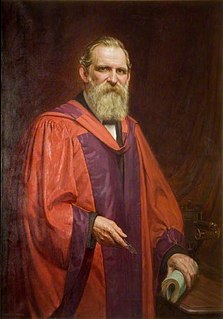
Charles Lapworth FRS FGS was an English geologist who pioneered faunal analysis using index fossils and identified the Ordovician period.

A Lagerstätte is a sedimentary deposit that exhibits extraordinary fossils with exceptional preservation—sometimes including preserved soft tissues. These formations may have resulted from carcass burial in an anoxic environment with minimal bacteria, thus delaying the decomposition of both gross and fine biological features until long after a durable impression was created in the surrounding matrix. Lagerstätten span geological time from the Neoproterozoic era to the present. Worldwide, some of the best examples of near-perfect fossilization are the Cambrian Maotianshan shales and Burgess Shale, the Devonian Hunsrück Slates and Gogo Formation, the Carboniferous Mazon Creek, the Jurassic Solnhofen limestone, the Cretaceous Santana, Yixian formations, the Eocene Green River Formation, and the Miocene Foulden Maar.

A trace fossil, also ichnofossil, is a fossil record of biological activity but not the preserved remains of the plant or animal itself. Trace fossils contrast with body fossils, which are the fossilized remains of parts of organisms' bodies, usually altered by later chemical activity or mineralization. Ichnology is the study of such trace fossils and is the work of ichnologists.

Climactichnites is an enigmatic, Cambrian fossil formed on or within sandy tidal flats around 510 million years ago. It has been interpreted in many different ways in the past, but is now thought to be a trace fossil of a slug-like organism that moved by crawling to on-shore surfaces, or near-shore, or burrowing into the sediment.
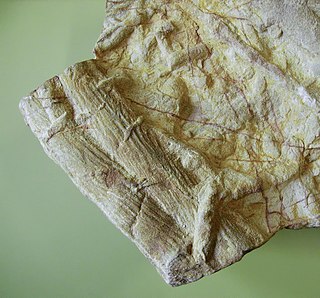
Cruziana is a trace fossil consisting of elongate, bilobed, approximately bilaterally symmetrical burrows, usually preserved along bedding planes, with a sculpture of repeated striations that are mostly oblique to the long dimension. It is found in marine and freshwater sediments. It first appears in upper Fortunian rocks of northern Iran and northern Norway. Cruziana has been extensively studied because it has uses in biostratigraphy, and because the traces can reveal many aspects of their makers' behavior.

Diplichnites are arthropod trackways with two parallel rows of blunt to elongate, closely spaced tracks oriented approximately perpendicularly to the mid-line of the trackway. The term is more often used for the ichnofossils of this description; however, similar trackways from recent arthropods are sometimes given this name as well.
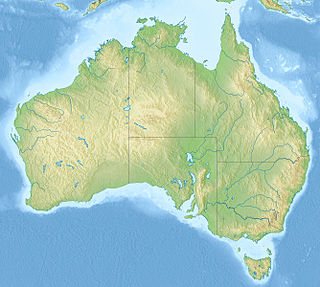
The Tumblagooda Sandstone is a geological formation deposited during the Silurian or Ordovician periods, between four and five hundred million years ago, and is now exposed on the west coast of Australia in river and coastal gorges near the tourist town of Kalbarri, Kalbarri National Park and the Murchison River gorge, straddling the boundary of the Carnarvon and Perth basins. Visible trackways are interpreted by some to be the earliest evidence of fully terrestrial animals.

Euthycarcinoidea are an enigmatic group of extinct possibly amphibious arthropods that ranged from Cambrian to Triassic times. Fossils are known from Europe, North America, Argentina, Australia and Antarctica.
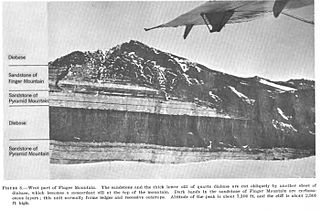
The Beacon Supergroup is a geological formation exposed in Antarctica and deposited from the Devonian to the Triassic. The unit was originally described as either a formation or sandstone, and upgraded to group and supergroup as time passed. It contains a sandy member known as the Beacon heights orthoquartzite.

Sir Richard Owen was an English biologist, comparative anatomist and paleontologist. Despite being a controversial figure, Owen is generally considered to have been an outstanding naturalist with a remarkable gift for interpreting fossils.
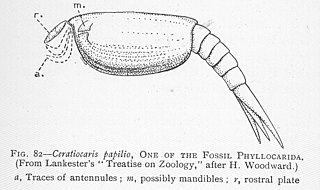
Ceratiocaris is a genus of paleozoic phyllocarid crustaceans whose fossils are found in marine strata from the Upper Ordovician until the genus' extinction during the Silurian. They are typified by eight short thoracic segments, seven longer abdominal somites and an elongated pretelson somite. Their carapace is slightly oval shaped; they have many ridges parallel to the ventral margin and possess a horn at the anterior end. They are well known from the Silurian Eramosa formation of Ontario, Canada.

The Potsdam Sandstone, more formally known as the Potsdam Group, is a geologic unit of mid-to-late Cambrian age found in Northern New York and northern Vermont and Quebec and Ontario. A well-cemented sandstone of nearly pure quartz, in the 19th century it was widely used in construction and in refractory linings for iron furnaces.
Blackberry Hill is a Konservat-Lagerstätte of Cambrian age located within the Elk Mound Group in Marathon County, Wisconsin. It is found in a series of quarries and outcrops that are notable for their large concentration of exceptionally preserved trace fossils in Cambrian tidal flats. One quarry in particular also has the distinction of preserving some of the first land animals. These are preserved as three-dimensional casts, which is unusual for Cambrian animals that are only lightly biomineralized. Additionally, Blackberry Hill is the first occurrence recognized to include Cambrian mass strandings of scyphozoans (jellyfish).

Paleontology in Wisconsin refers to paleontological research occurring within or conducted by people from the U.S. state of Wisconsin. The state has fossils from the Precambrian, much of the Paleozoic, and the later part of the Cenozoic. Most of the Paleozoic rocks are marine in origin. Because of the thick blanket of Pleistocene glacial sediment that covers the rock strata in most of the state, Wisconsin’s fossil record is relatively sparse. In spite of this, certain Wisconsin paleontological occurrences provide exceptional insights concerning the history and diversity of life on Earth.
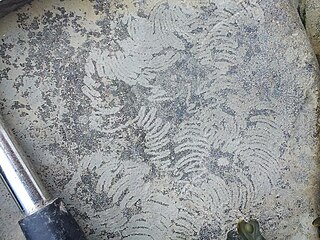
Nereites is a genus of trace fossil. Modern tracemakers of incipient Nereites include worm-like organisms, horseshoe crabs and hermit crabs. Traditionally, two models have been proposed for Nereites:
- in the ‘worm model’, Nereites is a feeding burrow produced by wormlike organisms, probing and backfilling laterally
- in the ‘arthropod model’, the characteristic lobes are pressure-release structures made by arthropod legs. According to this interpretation, Nereites is a locomotion trail

Edward Hitchcock erected the ichnogenus Bifurculapes, meaning "two little forked feet," for trace fossils that were discovered in the Early Jurassic Turners Falls Formation in the Deerfield Basin of Massachusetts. They are insect or crustacean trackways that consist of two rows of two to three tracks per series, with the two larger tracks being oriented parallel or oblique to the trackway axis. The third track, when present, is much smaller than the other two and is oriented approximately perpendicular to the trackway axis. Medial drag marks sometimes are present between the track rows. In trace fossil classification schemes based on behavior, Bifurculapes is considered a repichnion, or locomotion trace.
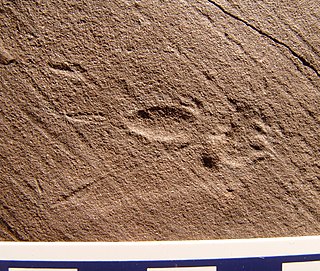
Cheliceratichnus, meaning trace of a chelicerate arthropod, is an ichnogenus erected for a body imprint discovered in the Lower Jurassic East Berlin Formation of Holyoke, Massachusetts. The specimen is now housed at the Springfield Science Museum, which is one of multiple museums on the Quadrangle. Considering that only a single specimen was found, the ichnogenus is monospecific, with the species name lockleyi honoring paleontologist and ichnologist Martin Lockley. In trace fossil classification schemes based on behavior, the body imprint is considered a cubichnion, or resting trace. Cheliceratichnus lockleyi exhibits the tagma characteristic of arthropods, with the trace divided into anterior, central, and posterior regions. Dalman and Lucas (2015) interpreted these regions as imprints of the chelicerae, prosoma, and opisthosoma, respectively, of a chelicerate arthropod. Additionally, imprints of the animal's legs and telson were identified. These authors noted that, in general, the pattern of the trace was similar to the body plan of the Solifugae, or camel spiders, but also noted that the presence of a telson imprint rules out that group because these animals lack telsons. Consequently, they attributed the trace to a solifuge-like arthropod without being more committal on what made it. In addition to the body imprint, the animal produced a trackway, called Acanthichnus cursorius, leading away from the body imprint, which demonstrates that the animal was alive at the time its body imprinted the sediment.
This article records new taxa of trace fossils of every kind that are scheduled to be described during the year 2019, as well as other significant discoveries and events related to trace fossil paleontology that are scheduled to occur in the year 2019.
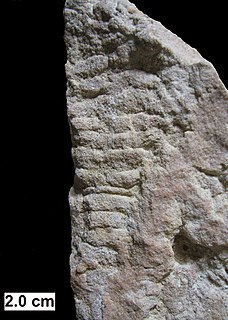
Mosineia is a genus of euthycarcinoid arthropods that lived on tidal flats of Laurentia at what is now central Wisconsin from the Middle Cambrian to the Late Cambrian. It contains a single species, Mosineia macnaughtoni. Associated trace fossil evidence suggests that this genus spent some of its time subaerially, possibly to mate and to feed on the microbial mats that blanketed the beaches. The genus is named after Mosinee---the city in Marathon County, Wisconsin, near which the fossils were found. The collecting site is known as Blackberry Hill, which is a well known Konservat-Lagerstätte that produces abundant exceptionally preserved fossils.
















